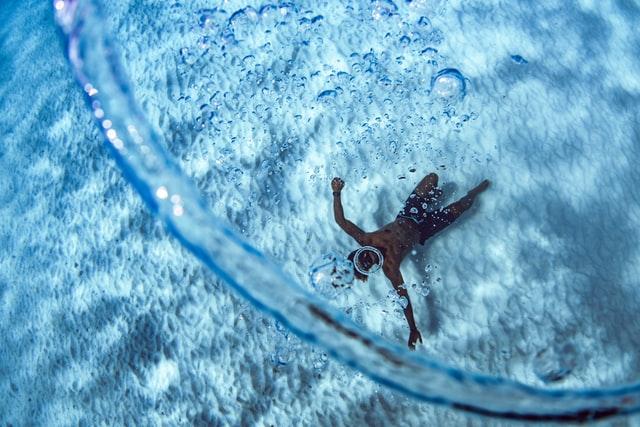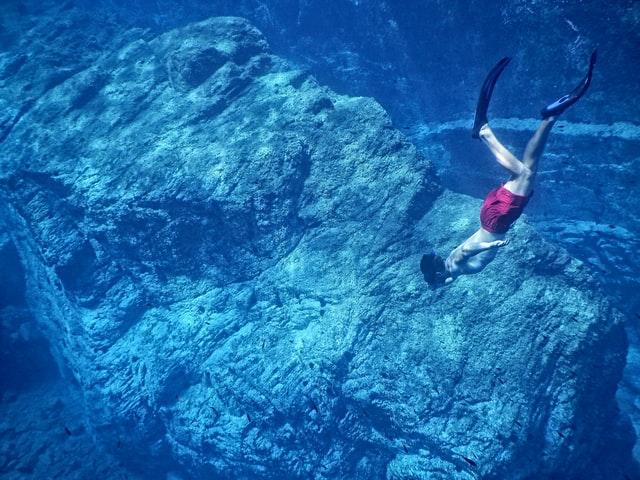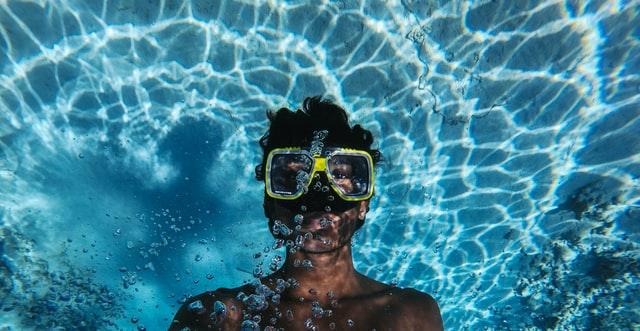Best Freediving Masks
Freediving is an activity where swimmers explore the ocean, however, they do so with just a mask while they hold their breath. Then, they dive down. When they need air again, they resurface.
Because free divers want to spend as much time as possible below the surface, it’s important to have a good quality mask that will let you truly enjoy the view. We’ve made a list of all the best freediving masks available, keep reading to learn more.

The Best Masks for Freediving
Cressi Nano Freediving Mask
The Cressi Nano is perhaps the most popular freediving mask on the market, and chances are you will come across someone who has one as you start freediving. These masks are lightweight, comfortable, and compactable—making them a great choice for travelers.
Made out of silicone, this mask will suction right to your face to keep the water out. The eye portions are also teardrop-shaped, improving visibility beneath you. It’s also easy to fit to your face and great for beginners who are just learning to free dive.
Pros:
- Excellent value
- Durable
- Comfortable
- Can fit any face type
- Great visibility
- Choice of colors
- Great for any level of free diver
- Compactable
Cons:
- Not the lightest option
- Not anti-fog, so you may need to purchase an additional product to keep the lens’ fog free
SalviMar Noah Freediving Mask
For those who want to feel like there is absolutely nothing on their face as the free dive, we can’t recommend the SalviMar Noah freediving mask. The lightest and most compact on the list, it still offers a wide range of visibility which isn’t true about most compact masks.
Just like the Cressi Nano, this mask is insanely comfortable. Unlike other masks, however, the silicone used for this one is hypoallergenic, making it a better choice for those with sensitive skin.
It’s adjustable but can be a bit difficult to find your perfect fit. Once you do, though, this mask is smooth sailing—or should we say smooth diving!
Pros:
- Comfortable
- Hypo-allergenic
- Great range of vision
- Lightweight
- Compact
- Easy to adjust
- Lots of colors to choose from
Cons:
- Not as durable as other masks
- Difficult to find the right fit
Mares X Viper
Mares is a popular free diving mask brand, and they’ve been around for many years, for a good reason! The Mares X Viper is a low-profile design known for being hydrodynamic, improving your speed underwater as you dive.
This is another very comfortable mask, and unlike others, it has a unique skirt design which makes it easy to place on your face and find the exact fit you need. It also has an anti-glare and anti-fog interior which is a nice feature when returning to the surface.
The price is also mid-range, which is great for either a beginner diver or someone who is looking to upgrade from the basic model. Just note that you can’t use this mask when you have facial hair, as the mask will not form a leak-proof seal when there is facial hair in the way.
Pros:
- Low-volume
- Easy to find your fit
- Performance Enhancing
- Anti-glare
- Anti-fog
- Multiple colors are available (even reef camouflage)
Cons:
- Can’t use with facial hair
- Not for all face types
Mares Star Liquid Skin Freediving Mask
Mares is such a good brand we had to feature a second one on our list. The liquid skin will absolutely leave you feeling like you are diving bare-faced. Like the Viper X, this mask is also built to be hydrodynamic allowing you to glide through the water.
This mask also has teardrop lenses which make it very easy to see beneath you as you dive. While this mask from Mares doesn’t have the same anti-glare properties as the Viper X, it is still anti-fog which can keep you from needing to purchase additional products when using this mask.
Be aware, however, that this is one of the pricier options on this list and that it doesn’t include any color options. Additionally, we think the straps are a bit thin, which, while it helps with the weightlessness, may affect the durability long term.
Pros:
- Lightest free diving mask
- Fits all faces, even small ones!
- Great field of vision
- Anti-fog
- Suitable for beginners or experienced
Cons:
- Expensive
- Straps don’t seem very durable
- Only comes in black (no camouflage)
Scuba Max Arc
Scuba Max Arc is one of the least expensive masks on our list but still gives you great quality for the price. While an experienced diver might want to go with a little more expensive of a mask, this one is great for a beginner.
The viewing windows are teardrop giving you the same wide range view as other masks, and it’s small, reducing your water drag.
What you are sacrificing with this mask is a lot of the bells and whistles found in more expensive masks, like extreme comfort, anti-fog, and anti-glare properties.
Pros:
- Inexpensive
- Low profile
- Wide range of view
- Great for beginners
Cons:
- Not anti-fog
- Not anti-glare
- Not as comfy as some of the other masks on this list
SeaDive Ray Blocker with Purge
If you really need anti-glare technology in your free dive mask, there is none better than the SeaDive Ray Blocker. With anti-reflective lenses, you will feel like you are wearing sunglasses underwater with this mask.
This mask is also very compact and comfortable, with a convenient one-pinch nose pocket. While it isn’t as low profile as some of the other options on this list, it is the perfect choice for someone who can’t enjoy freediving because of sensitive eyes.
You may be tempted to purchase the non-purge version of this mask to save a few dollars, we really think it is worth the upgrade to spend the extra money for the purge feature.
Pros:
- Anti-glare
- Low profile
- Split straps
- Comfortable
- Easy purge
Cons:
- Expensive
- Visibility is a bit sacrificed with anti-glare features
Hollis M1 Frameless Mask
For best vision, there is no freediving mask better than the Hollis M1 frameless mask. It sounds like just what it is, a mask with no frame, allowing you the most complete view of the ocean around you.
The glass on this mask is also premium, meaning you’ll have less distortion or glare as you will with another lens. You’ll pay for it, however, as this mask is not on the cheap end of the spectrum.
We love how lightweight this mask is and how easy it is to toss in a suitcase for traveling. With its premium quality, it can even transition to a scuba diving mask, and we definitely recommend it for someone who both scubas and free dives!
Pros:
- Excellent view
- Lightweight
- Packable
- Less glare
- Less distortion
- Can transition for scuba
Cons:
- Expensive

Do You Actually Need a Dedicated Freediving Mask?
If you are already a scuba diver, you might be looking at this list of masks and wondering whether you truly need to have a second mask dedicated to freediving, after all, can’t you just use your scuba mask?
While these two masks make look the same, most scuba masks are not low profile because they assume you will be wearing other gear, which will slow you down anyway, so why worry about making the mask lightweight? Freediving masks, on the other hand, are made for you to be able to move quickly through the water, allowing you to see as much as possible before you need to return to the surface for air.
But, that being said, if you are so inclined, you can use your scuba diving mask for freediving, you will just likely find that it is very bulky and uncomfortable. Additionally, the way the mask equalizes pressure is different from that of a freediving mask, limiting you to about 5 meters in depth when using a scuba mask for freediving.
If you are still against purchasing two masks, then buy a freediving mask that is transitionary, like the Hollis M1 Frameless Mask. This mask, while ideal for freediving, can also be used in the world of scuba diving, giving you the best of both worlds.

Tips for Choosing the Best Freediving Mask
A mask that may be the best for someone else probably won’t be the best for you. Freediving masks are highly individualistic, and below we’ve included a few tips for finding the one that fits you perfectly.
Mask Volume
The volume of a freediving mask refers to the amount of air the mask can hold. While you might think more air is better, less is actually better for freediving as you will need to equalize the pressure in the mask as you dive.
A low-volume mask won’t require a lot of air to equalize, letting you have more of your breath to scour the ocean floor. We recommend everyone who free dives to get a low-volume mask. A low-volume mask is one with a volume of less than 100mL
Comfort
Comfort is important when you are freediving for an extended period of time. It is also important if you plan to free dive frequently. The problem is that the more comfortable a mask is, the more expensive it will be.
In general, if you are just trying freediving on a vacation, comfort isn’t that important, and going with a cheaper mask is probably fine. If you are freediving frequently, however, it is 100% worth it to pay a little extra to have a comfortable mask. And if your skin is sensitive, definitely bust out an extra dollar for a hypoallergenic mask, as it will truly better your freediving experience.
Fit
Some masks fit almost any face, while others are made for long faces. People with petite faces or faces that are round may also have a hard time finding their perfect fit.
If you have a family member with the same face shape, it may be worth asking them for recommendations, otherwise, you should head to a store to try on some masks before you buy so you have an idea of the fit of each brand. If you must order online, just be sure to buy products that are returnable in case the mask absolutely does not fit you.
Lenses
The lenses are one of the most important parts of a freediving mask, and they are also the part that varies the most.
You have lenses that are anti-glare, anti-fog, and some which are teardrop shaped versus round. While it is unlikely to find all the technology you need in a single pair of lenses, you probably can if you want to pay a premium price.
If you have to sacrifice one feature, we recommend sacrificing anti-fog and buying lenses which are anti-glare and teardrop shaped. This is because you can easily buy an anti-fog solution for your lenses, but you can’t easily buy the anti-glare solution or change the shape of the lenses.
Color
While it may seem trivial, color is another critical aspect of free dive mask shopping. Many people free dive for the purpose of spearfishing, and unfortunately, fish are very scared of human eyes. Purchasing a camouflage color freediving mask can help with this as it can help you blend in with the reef.
If you are just freediving for fun, or to take a look around, it can be nice to buy a fun color, but don’t let it dictate your decision because sometimes black is best!
Hydrodynamic
The last thing you need to consider before you purchase a freediving mask is how hydrodynamic it is. Remember, with freediving, you want to go through the water as quickly as possible to see as much as possible, meaning you want as hydrodynamic of lenses as you possibly can.
Just know that when a mask is made hydrodynamic, it is also typically not as adjustable as other masks, so sometimes you’ll have to find a middle ground mask that fits your face and is as hydrodynamic as possible for that type of mask.
Link/Reference This Article
If you found the information in this article useful in your research, please link to use as the source using the tool below.
-
<a href="http://seatemperatures.net/blog/best-freediving-masks/"> Best Freediving Masks</a>
-
" Best Freediving Masks". SeaTemperatures.net. Accessed on July 27, 2024. http://seatemperatures.net/blog/best-freediving-masks/.
-
" Best Freediving Masks". SeaTemperatures.net, http://seatemperatures.net/blog/best-freediving-masks/. Accessed 27 July, 2024
-
Best Freediving Masks. SeaTemperatures.net. Retrieved from http://seatemperatures.net/blog/best-freediving-masks/.